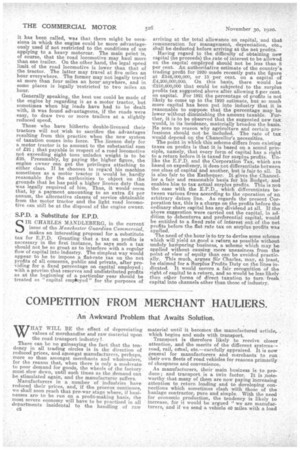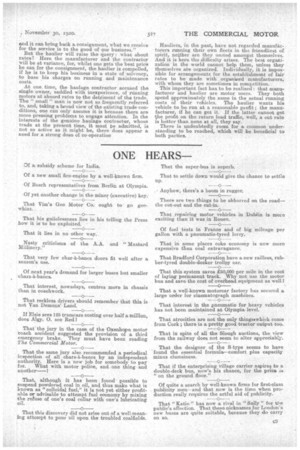COMPETITION FROM MERCHANT HAULIERS.
Page 2

Page 3

If you've noticed an error in this article please click here to report it so we can fix it.
An Awkward Problem that Awaits Solution.
WHAT WILL BE the effect of depreciating values of merchandise and raw inaterial upon the road transport industry? There can be no gainsaying the fact that the tendency in all trading circles is in the direction of reduced prices, • and amongst manufacturers, perhaps, more so than amongst merchants and wholesalers, for the reason that, when there is only a moderate to poor demand for goods, the wheels of the factory must slow down, until such times as the ,demand can be stimulated again, and the manufacturer suffers.
Manufacturers in a . number of industries have reduced their prices, and, if the process continues, we shall soon reach that pre-war stage where, if businesses are to be run on a profit-making basis, the most severe economy will have to be practised in all departments incidental to the handling of raw CS material until it becomes the manufactured article, which begins and ends with transport. Transport is therefore likely to receive closer attention, and the merits of the different systems— road, rail, ctnal, etc.—carefully appraised. It is now general for manufacturers and merchants to run their own fleets of road vehicles for reasons primarily of cheapness and convenience.
As manufacturers, their main business is to produce; and transport is a twin factor. It is noteworthy that many of them are now paying increasing attention to return loading and to developing connections which sometimes clash with those of the haulage contractor, pure and simple. With the need for economic, production, the tendency is likely to increase, for it would be argued "we are manufacturers, and if we send a vehicle 40 miles with a load and it can bring beak a consignment, what we receive i for the service s to the good of eur business." But the haulier will raise the query : what about rates? Here the manufacturer and the contractor will be at variance, for, whilst one gets the best price he can for the consignment, the haulier is compelled, if he is to keep his business in a state of solvency, to base his charges on running and maintenance costs.
At one time, the haulage contractor accused the single owner, saddled with inexperieece, of running motors at absurd rates to the detriment of the trade. The " small " man is now not so frequently referred to, and, taking a broad view of the existing trade conditions, one can only assume it is because there are more pressing problems to engage attention. In the interests of the genuine haulage contractor, whose trade at the present time, it must be admitted, is not so active as it might be, there does appear a need for a strong dose of cooperatiou Hauliers, in the past, have not regarded manufacturers running their own fleets in the friendliest of spirit, neither are they united amongst themselves. And it is here the difficulty arises. The best organization in the world cannot help them, unless they themselves are organized. Individually, it is impossible for arrangements for the establishment of fair rates to be Made with organized manufacturers, with whom they are sometimes in competition.
This important fact has to be realized : that manufacturer and haulier are motor users. They both spend approximately the. same in the actual running costs of their vehicles. The haulier wants his vehicle to be run at a reasonable peofit; the manufacturer, if he can get it. If the latter cannot get the profit on the return load traffic, well, a cut rate is better than none at all, they say.
There is undoubtedly roam for a, common understanding to be reached, which will be beneficial to both parties. .




























